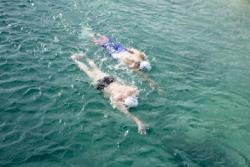Stop Swimming in Circles
 The hottest development in swimming is unquestionably swimming in the open water, not just because it made its Olympic debut in Beijing, but also because every week hundreds of novice triathletes and swimmers are taking the plunge. Open water swimming presents new challenges, various distances and diverse conditions distinct from pool swimming.
The hottest development in swimming is unquestionably swimming in the open water, not just because it made its Olympic debut in Beijing, but also because every week hundreds of novice triathletes and swimmers are taking the plunge. Open water swimming presents new challenges, various distances and diverse conditions distinct from pool swimming.
Open water races have been incredibly liberating. Though swimming in the open water poses a different mind-set than swimming back and forth in a well-marked pool, I have found that by swimming outside the box I can master skills far beyond what's possible in the pool. I swam my first swim meet 36 years ago. After seven years of high school and college pool competition, I got burned out. Handicapped by lack of speed, my pool races became predictable: I'd fall behind on the first lap, then doggedly try to catch up, or-because visibility in a pool is so good-helplessly watch faster swimmers pull away, while calculating whether I could flip for my final 50 before being lapped.
My first open water race, during a lifeguard tournament at Jones Beach on Long Island in 1973, was a life-changing experience. At the starter's signal, a pack of us dashed into the water, dove under-or was knocked back by-the shore break and began swimming furiously.
A breathless blur of sea, sky and brief flashes of indistinguishable fellow swimmers replaced the predictability of the pool. And my slow-twitch muscle fibers suddenly mattered very little and comfort with waves and chop, from years of bodysurfing, seemed to matter far more. That former sense of swimming against rivals was replaced by a feeling of striving together to find our way through the waves. When I ran up the beach 10 minutes later, I was so exhilarated; I couldn't wait to do it again!
In the years since, I've continued to hone my open-water skills-distinct from pool skills-to the point where, since turning 55, I've won USMS championships, broken national records and been the top-ranked 55-59 open water swimmer. Pretty heady stuff for someone who was cut from his grammar school swim team and never escaped the slow lane in high school. Here's my message: If I can experience success and satisfaction in open water, you can too. But first you have to fill out the entry form. To encourage you, here are tips for your first race:
The Goal
Your first-race goal should be to finish the race eager to do another because you: (1) calmly adapted to the conditions you encountered, (2) swam with good form and unwavering focus and (3) finished pleasantly surprised by your time or place-and confident you can swim even better next time.
The Tune-up
Experienced athletes know the importance of warm-up before exertion. I use my pre-race preparation to tune up (1) my neuromuscular system for the task of swimming efficiently, possibly in challenging conditions and (2) my mind for the focus that blocks distraction. I've developed specific "stroke thoughts" that accommodate swells and chop. I take my focal points for a "test drive" of 400 meters or more to remind myself what works, get mind and muscles talking, and practice the calm mental state I want to maintain when things get hectic.
The Start
If you feel anxious, stand at the fringes. While waiting, calm your jitters by surveying the lifeguards. They'll help keep you on course, and be at your side quickly if need be. Finally, look inward and vividly visualize how you want to feel while swimming.
The most common rookie mistake is to see the pack start splashing away furiously and panic, for fear of being swamped or left behind. To prevent that, plan on starting as if for a solo practice swim-focused on "grooving" your stroke and feeling like you could swim that way indefinitely.
In cooler water (mid-60s or below), you may experience gasping after the start. If so, swim breaststroke with gliding strokes and slow, steady exhales. Normal breathing should return in under a minute; when it does, resume freestyle, maintaining steady outbreaths.
Stealth Racing
After about 50 meters of what might seem like a crowded, splashy churning start, the field will spread out and the pace will ease. At this point, you'll probably see quite a few caps ahead of you. That's good because they can be a convenient navigational guide. Also, most of them went out too fast and will get progressively slower, allowing you to enjoy passing them without even trying because you stay steady as they slow down.
Stealth racing also means cultivating a kind of tunnel vision. Even with people all around-and sometimes in contact-focus on creating a cocoon of calm purpose. Observe how others are swimming, then focus on swimming with slower, quieter strokes until you're matching their pace effortlessly. Then stealthily add the slightest bit of effort and start edging forward until you find another swimmer or group with whom to play the same game.
Finishing
On most courses, you'll have only a vague idea how far you've swum. In a pool race, the lap counter constantly reminds you how far you still have to swim; in open water you can lose your sense of time and distance. That's a positive: It should help you stay in the moment and keep your pace cautious. Just keep thinking that your goal is to finish feeling pleasantly surprised by your time and place.
See you at the start!
Terry Laughlin is founder and Head Coach of Total Immersion Swimming. This article is excerpted from his next book, Outside the Box, to be released as an ebook in June.
Categories:
SIGN UP FOR UPDATES FROM USMS
















